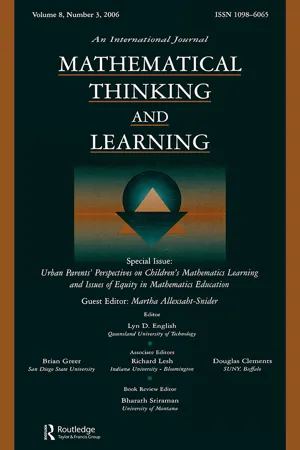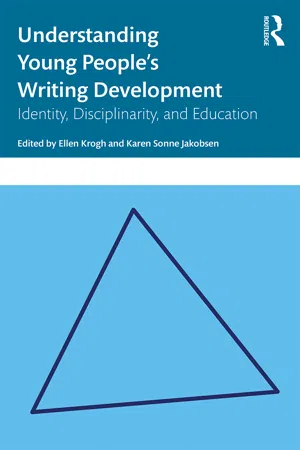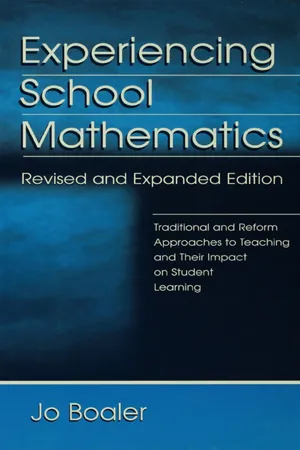Technology & Engineering
Maths Identities
Maths identities are mathematical equations that are true for all values of the variables involved. They are used to simplify and solve mathematical problems, and are fundamental in various engineering and technological applications. These identities include trigonometric identities, logarithmic identities, and algebraic identities, and are essential for solving complex mathematical problems in engineering and technology.
Written by Perlego with AI-assistance
Related key terms
Related key terms
1 of 4
Related key terms
1 of 3
5 Key excerpts on "Maths Identities"
- eBook - ePub
- Harry Daniels(Author)
- 2012(Publication Date)
- Routledge(Publisher)
Among sociologists of education, Bernstein has perhaps developed the most useful grammar for addressing the connections between the macro forces in society and the micro nature of pedagogic interactions. He developed a strong grammar, that is, with a conceptual syntax capable of generating unambiguous empirical descriptions, and while this language presents great challenges to research students who want to understand and work with his theories it is precisely its strength that makes it so powerful and applicable. Furthermore, as Bernstein himself explains (1993), his theory and Vygotsky's have the same origins and inspiration: that of Marx. Worked together, I and many others have found that these sociological and cultural-historical theories respectively provide insights into how children learn in a way that enables one both to understand how and why children fail and to be able to propose and research strategies to do something to change that. In the mathematics education research community we have built up a substantial body of work based on ethnomathematics (d'Ambrosio, 2010) and also on critical approaches that have nevertheless, I suggest, not provided us with appropriate tools to achieve those changes. We need the sociological insights and the cultural-historical analysis offered by these two great thinkers.The notion of identity in educational thinking
Perhaps the key impetus for this focus on identity in education can be attributed to Jean Lave who wrote:We have argued that, from the perspective we have developed here, learning and a sense of identity are inseparable: They are the same phenomenon. (Lave and Wenger, 1991: 115)While her perspective has been taken up in most areas of education (Kirshner and Whitson, 1997) it has had particular impact in mathematics education because of the associated influence of her work on situated cognition which developed from Lave's studies of mathematical activity in apprenticeship situations (Watson and Winbourne, 2007). Furthermore, the idea, at the heart of the mathematics school curriculum all over the world, that mathematical knowledge learned in the abstract in school can be applied by students outside school in everyday problems, the notion of transfer, is comprehensively challenged by the idea that knowledge is situated, not carried in decontextualized concepts in the mind. Differences between within school and out-of-school competences were also challenged by Nunes et al. - Martha Allexsaht-Snider, Martha Allexsaht-Snider(Authors)
- 2018(Publication Date)
- Routledge(Publisher)
One becomes an athlete, musician, reader, writer, or mathematician through participatory practice, as well as learning skills and knowledge. According to Lave and Wenger (1991), "learning and a sense of identity are inseparable: they are aspects of the same phenomenon" (p. 15). A view of learning that accounts for socioculturally constructed identity recognizes that the meanings of learning go far beyond discreet skills and facts. Although the terms personhood (Egan-Robertson, 1998) and subjectivity (McCarthey, 1998) have also been used in literacy research to account for positions and relationships that are constituted through situated practice, we have chosen the term social identity because it foregrounds the sociocultural aspects of identity formation. In respect to mathematics and identity, "students do not just learn mathematics in classrooms, they learn to be, and many students develop identities that give negative value to the passive reception of abstract knowledge" (Boaler & Greeno, 2000, p. 188). In advocating for active and critical mathematics curriculum, Boaler and Greeno suggested that identities of agency, developed in participatory classrooms where students generate questions, discuss problems, evaluate validity, and "contribute more of their selves" (p. 189), may be crucial to mathematics success. In classrooms and communities, children engage in legitimate literate and mathematical activities, but they may or may not concurrently construct equally powerful identities as readers, writers, or mathematicians. Cultural and social factors, including positions as socially classed, raced, gendered, and ethnic persons, are implicated in their identity formation as well as instruction and practice. In addition, what counts or is perceived as literate or mathematical knowledge may have a profound effect on children's classroom experience and forming identities- eBook - ePub
Understanding Young People's Writing Development
Identity, Disciplinarity, and Education
- Ellen Krogh, Karen Sonne Jakobsen, Ellen Krogh, Karen Sonne Jakobsen(Authors)
- 2019(Publication Date)
- Routledge(Publisher)
We perform identity work by constructing ourselves as credible members of a particular social group, so that identity is something we do; not something we have. Almost everything we say or write, in fact, says something about us and the kind of relationship we want to establish with others.(Hyland 2009, p. 70)We all do identity all the time, and this doing Gee (2003) calls identity work . Identity can thus be understood as negotiated ways of participating in different social groups, cultures, and institutions, and one of these forms of participation is writing. The concept of identity as it is understood in this chapter is therefore linked to an understanding of writing as a social practice (Barton 2007; Prior 2006; Smidt 2009).Hence writing development involves identity work (Gee 2003) where students consciously or subconsciously work to construct and establish social identities that are regarded as acknowledgeable in the writing cultures in which the students’ mathematical writing is embedded.As Morgan shows, doing this, i.e. identity work, is important for students in mathematics not least because their writing is often assessed by teachers and external examiners.(Morgan 2006, p. 239)While establishing appropriate identities is of importance to participants in any situation, it is of critical importance to students at all levels whose oral and written productions are to be assessed. It is necessary to establish a degree of authority and confidence that will convince a reader-assessor-teacher without alienating them.Based on the interviews I conducted, it is clear that this is also the case for writing in the subject mathematics. The extract below is taken from an interview with the student Kasper. Kasper was one of the students I followed on the stx programme, which is a 3-year programme in Denmark (years 11 to 13). The interview was conducted when Kasper’s class had just completed the second year of their mathematics teaching. In the interview, we talk among other things about a multidisciplinary assignment that Kasper has worked on shortly before the interview. I ask Kasper whether it is important for him that he has the possibility to shape the format, content and use of his mathematical texts. For Kasper, this is not essential. In contrast to the subject Danish, for example, the subject mathematics does not set the stage for adding a personal touch to written assignments according to Kasper. - eBook - ePub
Experiencing School Mathematics
Traditional and Reform Approaches To Teaching and Their Impact on Student Learning, Revised and Expanded Edition
- Jo Boaler(Author)
- 2002(Publication Date)
- Routledge(Publisher)
Traditional teaching methods have been challenged on many counts, with suggestions that they are not interesting and that they give students little opportunity to construct understanding. But situative perspectives add something new and different to the conversation because they focus on the classroom practices that define the knowledge produced, suggesting that practices of individualized, abstract procedure reproduction “deny students the chance to engage the relevant domain culture” (Brown, Collins, & Duguid, 1989, p. 34). Neither professional mathematicians (Burton, 1999a, 1999b) nor professional users of mathematics (Noss, 1994) spend their time reproducing standard procedures – that is a particular practice specific to the mathematics classroom. Yet the specificity of that practice may be the single most important factor reducing achievement and affiliation for students. The suggestion that mathematics teaching approaches should offer varied, realistic constraints and engage students in discussion and negotiation is far from new, but the situated perspective adds another dimension to such proposals. For if learning mathematics entails more than the construction of cognitive forms, but the development of practices through which identities with the discipline are formed, then repeated and limited practices of procedure repetition will limit the identities of all students who do not go beyond such practices. A classroom community that lacks the practices of mathematical problem solving may bound (Siskin, 1994) students’ knowledge and give them passive identities as receivers, rather than users of mathematics knowledge. Thus, it is not the extent of knowledge that is in question, but its accessibility.At Phoenix Park, the students were probably less motivated to do well in examinations. They spent less time on task in lessons, they had not been introduced to all of the content and procedures they needed in the examination, and they were not even given the necessary equipment for the examination. But the students were more successful in the examination, and in applied and long-term assessments, apparently because they had developed more effective forms of knowledge and more productive identities as mathematics learners. They were able to use mathematics in a range of different situations; and the reason for this was not because they had learned it in a clear and straightforward way, but because they had used mathematics in a similar way in the classroom. They had engaged as mathematical problem solvers, and they were willing to consider any mathematical situation and think about what was involved. As Sue said, when they used mathematics outside school, it felt the same – it “had the same atmosphere” as their project-based mathematics. Even the vast differences between the nature of Phoenix Park’s open-ended projects and the GCSE examination did not faze the students. This was because they did not regard the two assessments as inherently different: - eBook - ePub
Gender in the Classroom
Foundations, Skills, Methods, and Strategies Across the Curriculum
- David Sadker, Ellen S. Silber(Authors)
- 2016(Publication Date)
- Routledge(Publisher)
7
Gender Equity Intersects WithMathematics and Technology:Problem-Solving Educationfor Changing Times
Karen N. BellState University of New York at New Paltz
Karen NorwoodNorth Carolina State University
T his chapter's focus is to provide a lens through which to view mathematics, technology, and their instruction. It is our intention to demonstrate that mathematics and technology are important to everyone, that the disciplines have intrinsic beauty, and that they provide an excellent mode for the communication of complex ideas. We also explore how cultural factors have shaped attitudes toward mathematics, and we suggest a variety of instructional practices that can be implemented to foster more equitable learning and greater appreciation of mathematics and technology.In this chapter we explore four Essential Equity Questions (EEQs) for use with preservice teachers who are working to develop their repertoire of instructional tools at the elementary or middle school levels, with in-service teachers through ongoing professional development, as well as with modifications for use with elementary and middle school pupils themselves.The EEQs addressed in the chapter are as follows:- Essential Equity Question 7.1: Why is mathematics important?
- Essential Equity Question 7.2: Are there gender differences in cognitive ability or learning style in mathematics and technology?
- Essential Equity Question 7.3: What kinds of social and cultural factors influence gender differences in cognitive abilities or in academic performance pertaining to mathematics and technology?
- Essential Equity Question 7.4: What kinds of instructional and assessment strategies foster mathematics and technology achievement for all students in the classroom?
A section titled What We Know, which is a brief overview of gender-related research that focuses on mathematics and technology, follows each EEQ. Scattered throughout the chapter are Interactions, which are tested classroom activities that assist individuals in discovering and understanding their relationship to mathematics and technology. These activities are designed to challenge assumptions and break down barriers that may stand in the way of fully knowing and appreciating the value and beauty of mathematics and the technological world. They also provide a new lens from which to view the disciplines of mathematics and technology, so their value and approaches to problem solving can be used in all arenas of life.
Index pages curate the most relevant extracts from our library of academic textbooks. They’ve been created using an in-house natural language model (NLM), each adding context and meaning to key research topics.
Explore more topic indexes
Explore more topic indexes
1 of 6
Explore more topic indexes
1 of 4




